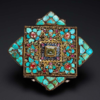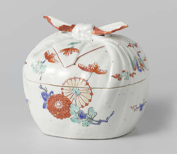HILDA MAK
Curator at the Hong Kong Museum of Art (HKMoA)

LAST YEAR MARKED the 500th anniversary of the ascension to the throne by Zhu Houcong, the Jiajing emperor (1507–1567). In celebration of this milestone, the Hong Kong Museum of Art (HKMoA), in collaboration with the renowned Huaihaitang Collection, has organised an exhibition focused on the emperor, titled “Eternal Enlightenment: The Virtual World of Jiajing Emperor”, running from December 9th, 2022 to June 14th, 2023.
The life of the Jiajing emperor was extraordinary. At thirteen years of age, he went from being a vassal prince to the ruler of the Ming dynasty (1368–1644), over which he would reign for the next forty-five years. In the early years of his reign, he reformed the corrupt ways of the previous regime and was a diligent ruler, who welcomed wise counsel and did not tolerate sycophancy at court. Furthermore, he reduced taxes while fortifying the country’s defences. During this period, the Ming court was given a new lease of life. However, in the middle and later periods of his reign, corruption among officials became rampant, leading to a number of peasant revolts and mutinies. Moreover, the country was devastated by a huge earthquake, while the Mongols and pirates attacked from north and south.
During the Jiajing era (reigned 1522–1566), the Ming dynasty was plagued by internal strife and foreign threats. In 1542, the emperor moved to the West Park where he lived until his death. He devoted himself to pursuing immortality and building temples and palaces. Imperial porcelain designs during his reign were greatly influenced by his Daoist beliefs, while the quantity of porcelain wares ordered from the Jingdezhen kilns by the imperial court also increased substantially. Through his design of the West Park, usage of vast quantities of porcelain wares and practice of Daoist ritual, the emperor was seemingly building his own idealised immortal land, just like a virtual world today, where he could one day transcend the temporal realm and achieve immortality. In the exhibition, we hope to shed light on the struggles and aspirations of this legendary Ming emperor by featuring artefacts that have survived from the period (1).
The emperor knows no ease
In April 1521, the Zhengde emperor (1491–1521) died without an heir (2). Empress Dowager Cishou (1471–1541) and Grand Secretary Yang Tinghe (1459–1529) agreed that Zhu Houcong, the son of Prince Xian of Xing (1476–1519), would become the next emperor. This decision was based on the principle that “the throne of the emperor, who dies without an heir, shall pass to his younger brother”, as stated in Huang-Ming zuxun (Instructions of the Ancestors of the August Ming). Zhu was the grandson of the Chenghua emperor (1447–1487) and the cousin of the Zhengde emperor.

Hoping to continue the Hongzhi emperor’s (1470–1505) lineage, officials first named Zhu as crown prince before formally enthroning him. They even requested that Zhu name the Hongzhi emperor as “Huangkao” (Late Imperial Father) and renamed his birth father “Huangshufu Xing Xian Da Wang” (Imperial Uncle Prince Xian of Xing) and his birth mother “Huangshumu Xing Xian Wang Fei” (Imperial Aunt Consort Xian of Xing). To his birth mother, Zhu was to refer to himself as “Zhi Huangdi” (Emperor Nephew). Understandably, he resisted such requests. These disagreements planted the seeds for the future tension between the young Jiajing emperor and his officials over matters of ritual arrangements that would culminate in the Great Rites Controversy.
Despite his tender age and not yet having established his power at court, the Jiajing emperor’s assertive character was reflected in the various contentious incidents between him and court officials during the early years of his reign. In Liechao nianhao bianwu (Correction of errors in reign titles), it is recorded that when the Jiajing emperor ascended to the throne, the Grand Secretariat recommended “Shaozhi” as the era name. The shao in the proposed title connotes “to inherit” or “legacy”, therefore “Shaozhi” meant “to continue the lineage of the Hongzhi emperor”. Eventually, the emperor decided on “Jiajing” as his reign title instead, signalling that he was not the offspring of the Hongzhi emperor and that his succession to the throne meant only a continuation of the dynasty and not the late emperor’s lineage. The name “Jiajing” was derived from the “Wuyi” chapter of Shangshu (Book of Documents): “Gentlemen do not remain idle… [Emperor Zhongzong of the Shang dynasty] dared not neglect his governing duties and grow idle and complacent; he was good at maintaining peace and stability in the empire.” It was an exhortation for a monarch to govern diligently to ensure peace and prosperity in his empire (3).

The Jiajing emperor loved his parents deeply. It was recorded that “in his roughly forty-year reign, [the emperor] never stopped honouring the memory of Emperor and Empress Xian. On every seasonal occasion or the anniversaries of their deaths, his servants and officials would see him looking sorrowful while showing great devotion. All who saw him could not bear it and would shed a tear.” He asked the Ministry of Rites multiple times to bestow on his parents honorary titles, but to no avail. Eventually, on the fifth day of the ninth month of the third year of his reign, the emperor defied the objections of his officials and decreed that the Hongzhi emperor be named as “Huang-bokao” (Late Imperial Uncle), his birth father “Huangkao” (Late Imperial Father) and his birth mother, Empress Dowager Zhangsheng, “Shengmu” (Holy Mother).

Displayed in this exhibition is the Gaoshang Yuhuang benxing jijing (Combined scriptures of the original acts of the exalted and superior Jade Sovereign) (4a), printed by Empress Dowager Zhangsheng on the tenth day of the eighth month of the third year of the Jiajing period, which was also the birthday of the emperor. The Great Rites Controversy, which took place the same year, came to a close with the emperor’s enforcement of his will over the opposing officials and their punishment. The scriptures were also significant for being affixed with the Zhangsheng Huangtaihou Bao seal, as the Empress Dowager had only been granted the “Zhangsheng” title the same year (4b).

Seeking the Dao
The Jiajing emperor’s belief in Daoism stemmed from his father’s influence. Historical records state that “Emperor Xian carried the moniker ‘Chunyi Priest’ and would practise abstinence at [a hall], hence the latter being named Chunyi Hall”. In the early years of his reign, the Jiajing emperor’s Daoist activities were limited, but that changed after the palace plot of 1542 in which a group of sixteen female courtiers unsuccessfully attempted to murder him in response to his cruel treatment of young girls in the palace; subsequently, he moved to the West Park and devoted himself fully to Daoist practice (5).

By the mid-Jiajing period, the country was in a state of decline. According to historical accounts, “even though the emperor did not hold court in his later years, he was still diligent in attending to matters of governance. He may have retreated into a reclusive existence, but he still held the reins of power.” Even so, various trials and tribulations would push the emperor further in his pursuit of immortality.
The average number of imperial porcelain items supplied each year by the Jingdezhen kilns to the imperial court increased from over 4,000 to more than 30,000. Nearly 600,000 porcelains were produced during this period. The symbol of the Eight Trigrams (bagua), which is central to Daoism, was incorporated on many of these porcelain wares. The Eight Trigrams originate from the Yi Jing (Book of Changes), each made up of three lines and representing eight natural elements: heaven (qian), earth (kun), thunder (zhen), wind (xun), water (kan), fire (li), mountains (gen) and marshes (dui) (6). The ubiquity of such motifs is arguably related to the Daoist rituals frequently held at the time at court. According to Mingshizong shilu (Veritable records of the Emperor Shizong of the Ming dynasty), the Jiajing emperor’s prayers, in the course of more than 200 Daoist ritual ceremonies, included wishes for the empire’s peace and prosperity, rainfall, to be free from illness and disaster, and for longevity and abundant offspring, among others.

The nature of Dao
The concept of qi is integral to Daoism. As stated in the Daodejing (Scripture of the way and its virtue), “Dao gives birth to One, One to Two, Two to Three, and Three to all things in the universe. All things carry Yin and embrace Yang, the two of which combine to achieve harmony.” The “One” mentioned above refers to qi. In Daoism, qi is believed to originate from Dao and exist between Heaven and Earth, being the constituent elements of all beings. On Jiajing era relics, such a notion is often manifested by depicting entwining auspicious characters growing out of rocky mountains, sea waves, or lingzhi fungus (7). This is because rocks were deemed to contain the essence of earth, and lingzhi fungus was seen as an important material in alchemy for producing elixirs that grant immortality. During his stay in the West Park, the Jiajing emperor ordered several times that lingzhi fungus be supplied from various places.


Other Daoist patterns linked to the concept of qi include…
Click here to access Arts of Asia‘s Summer 2023 issue for the full article.

 Subscribe
Subscribe Calendar
Calendar Links
Links Gift
Gift

